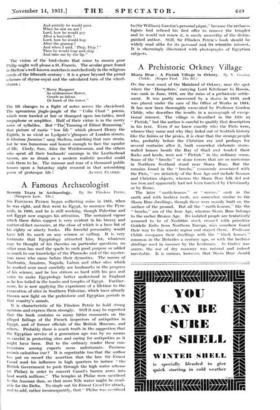A Prehistoric Orkney Village
Skara Brae : A Pictish Village in Orkney. By V. Oortion Childe. (Kogan Paul. Ws: 13d. ) ON the west coast of the Mainland of Orkney, near the spot where the Hampshire,' carrying Lord Kitchener to Russia, was sunk in June, 1916, are the ruins of a prehistoric settle- ment. It was partly uncovered by a storm in 1850, and was placed under the care of the Office of Works in 1894. It has now been thoroughly excavated by Professor Gordon Childe, who describes the results in a monograph of excep- tional interest. The village is described in the title as " Pictish," but the author is careful to qualify that description in his text. Even if we knew exactly who the Picts were, whence they came and why they faded out of Scottish history like the fairies or the pixies, it is clear that the strange people who, probably before the Christian era and perhaps for several centuries after it, built somewhat elaborate stone- walled houses beside the Bay of Skail and tended their flocks and herds, were not " Pictish " in the ordinary sense, Some of the " brochs " or stone towers that arc so numerous in Northern Scotland stand near Skara Brae. But the remains found in the " brochs," commonly associated with the Picts, " are definitely of the Iron Age and include Roman and Christian objects, whereas the Skara. Brae folk did not use iron and apparently had not been touched by Christianity or by Rome.
The later " earth-houses " or " wee:11s," sunk in the earth and with beehive roofs, are somewhat similar to the Skara Brae dwellings, though these were mainly built on the surface of the ground. But all the " earth-houses," like the " brochs," are of the Iron Age, whereas Skara .Brae belongs to the earlier Bronze Age. Its isolated people are tentatively assumed to be of Neolithic stock crossed with primitive Goidelic Belts from Northern Europe, who somehow found their way to this remote region and stayed there.. Professor Childe compares their dwellings with the " black houses " common in the Hebrides a century ago, or with the beehive shielings used in summer by the herdsmen. As timber was scarce, the use of dry masonry was natural and indeed inevitable. It is curious, however, that Skara Brae slimild
have been deserted, to all appearance, before the Iron Age began. Professor T. IL Bryce, in a note on the four skeletons unearthed, states that the Skara Brae folk were a mixed population very much the same as that of the present day, without the special Norse characteristics introduced much later by the Vikings. Thus, when all is said, the mystery of Skara Brae remains. But Professor Childe's detailed descriptions are singularly clear, and his long and fine series of photographs gives a very vivid picture of this remarkable prehistoric site that is unique in Britain.



































 Previous page
Previous page